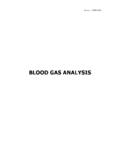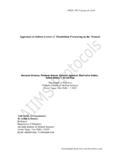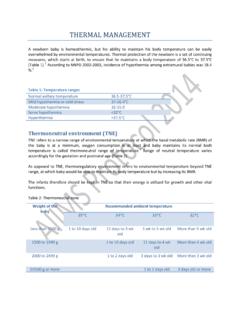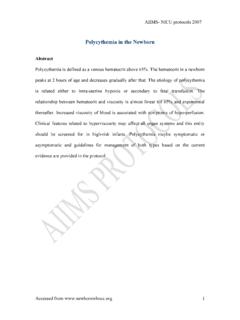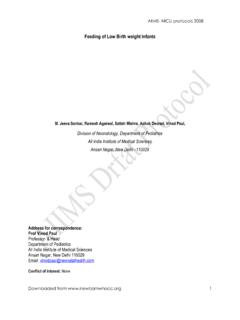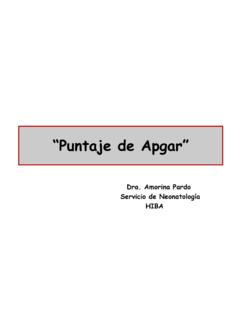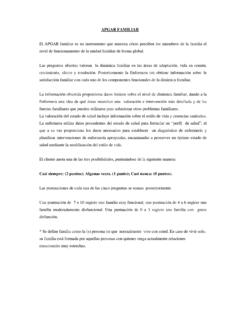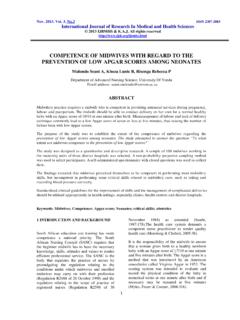Transcription of Post-resuscitation management of asphyxiated neonates
1 AIIMS- NICU protocols 2007 Post-resuscitation management of asphyxiated neonatesRamesh Agarwal, Ashish Jain, Ashok Deorari, Vinod K Paul Division of Neonatology, Department of PediatricsAll India Institute of Medical SciencesAnsari Nagar, New Delhi 110029 Address for correspondence:Dr Vinod K PaulProfessorDepartment of PediatricsAll India Institute of Medical SciencesAnsari Nagar, New Delhi 110029 Email: from AIIMS- NICU protocols 2007 Abstract Inspite of major advances in monitoring technology and knowledge of fetal and perinatal medicine, Perinatal asphyxia is one of the significant causes of mortality and long term morbidity.
2 Data from National Neonatal Perinatal database suggests that perinatal asphyxia contributes to almost 20% of neonatal deaths in India. Failure to initiate or sustain respiration after birth has been defined as criteria for the diagnosis of asphyxia by WHO. Perinatal asphyxia results in hypoxic injury to various organs including kidneys, lungs and liver but the most serious effects are seen on the central nervous system. Levene s classification is a useful clinical tool for grading the severity of hypoxic ischemic encephalopathy. Good supportive care is essential in the first 48 hours after asphyxia to prevent ongoing brain injury in the penumbra region.
3 Strict monitoring and prompt correction is needed for common problems including temperature maintenance, blood sugars, blood pressure and oxygenation. Phenobarbitone is the drug of choice for the treatment of convulsions. Key words : Asphyxia, HIE, Downloaded from AIIMS- NICU protocols 2007 According to latest estimates by World Health Organization (WHO), approximately 4 million babies die each year before they reach the age of one month1. Ninety-eight percent of these neonatal deaths take place in the developing countries.
4 Perinatal asphyxia and birth injuries together contribute to almost 29% of these deaths1. Most of the births in developing countries occur at home, usually attended by untrained birth attendants. Failure to initiate and sustain breathing immediately after delivery has been associated with hypoxic-ischemic injury to the central nervous system (CNS) and the clinical manifestations of this injury have been termed as Hypoxic Ischemic Encephalopathy (HIE). Some experts prefer to use tern neonatal encephalopathy , as it is not always possible to document the hypoxic ischemic insult and there may be potential several other etiologies operating. HIE is of concern in an asphyxiated neonate because it can lead to serious long-term neuro-motor sequelae among gold standard definition of birth asphyxia does not exist.
5 It is probably better to use the term perinatal asphyxia since asphyxia may occur in utero, at birth or in the postnatal period. WHO2 has defined perinatal asphyxia as a failure to initiate and sustain breathing at birth The National Neonatal Perinatal Database (NNPD), 2000 used a similar definition for perinatal asphyxia3. It defined moderate asphyxia as slow gasping breathing or an Apgar score of 4-6 at 1 minute of age. Severe asphyxia was defined as no breathing or an Apgar score of 0-3 at 1 minute of from AIIMS- NICU protocols 2007As per the AAP (American academy of Pediatrics) and ACOG ( American college of Obstetrics and Gynecology), all the following must be present for designation of asphyxia Viz (a) Profound metabolic or mixed academia (pH< ) in cord.
6 (b) Persistence of Apgar scores 0-3 for longer than 5 minutes. (c) Neonatal neurologic sequelae (eg, seizures, coma, Hypotonia). (d) Multiple organ involvement (eg, of the kidney, lungs, liver, heart, intestine)Definitions based on Apgar scores may be useful as it can be used for formulating guidelines for post -asphyxial treatment of neonates . Apgar scores are also useful for predicting long term outcome in infants with perinatal asphyxia4,5. Indian dataAccording to NNPD 20003 data collected from 17 tertiary neonatal intensive care units in India, Apgar scores <7 at 1 minute (includes moderate and severe asphyxia) were documented in 9% of all intramural deliveries2.
7 Babies continued to have Apgar scores <7 at 5 minutes of age. Bag and mask ventilation was used in infants and less than 1% infants needed cardiac compressions and/ or medications for resuscitation at birth. Perinatal asphyxia was responsible for 20% of all neonatal deaths. Manifestations of HIE were seen in approximately of all babies. Perinatal asphyxia was the commonest cause of still-births accounting for one-third of all such cases. Systemic consequences of asphyxiaPerinatal asphyxia leads to muti-organ dysfunction. Virtually any organ can be effected. And care in the nursery should be oriented to determining the presence or the absence of dysfunction of the critical organ Many of these complications are potentially Downloaded from AIIMS- NICU protocols 2007fatal.
8 In term infants with asphyxia, renal, CNS, cardiac and lung dysfunction occur in 50%, 28%, 25% and 25% cases, respectively6. The extent of organ system dysfunction determines the early outcome of an asphyxiated neonate (Table 1).Metabolic involvement may include hypocalcemia, hyponatremia (as a result of SIADH or direct renal injury), and alterations in glucose metabolism. There may be haematological alterations (thrombocytopenia and DIC) Hypoxic ischemic encephalopathy (HIE) refers to the CNS dysfunction associated with perinatal asphyxia. HIE is of foremost concern in an asphyxiated neonate because of its potential to cause serious long-term neuromotor sequelae among survivors.
9 A detailed classification of HIE in term neonates was proposed by Sarnat and Sarnat7. A simple and practical classification of HIE by severity of manifestations provided by Levene is recommended for routine use (Table 2)8. Evolution of HIE changesHypoxic-ischemic brain damage is a gradually evolving process, which begins during the insult and extends beyond the resuscitation period. Although the initial brain injury (phase of energy failure) is related to hypoxia and ischemia, subsequent reperfusion and generation of free radicals contributes to ongoing injury. The initial hypoxic-ischemic injury results in an area of infarction. The immediate area surrounding this area is termed as penumbra.
10 The penumbra continues to show adverse changes in the form of neuronal necrosis or apoptosis (programmed cell death) even after the hypoxic insult is over. It is possible that these post -hypoxic changes in the penumbra area may be amenable to therapeutic interventions. The duration of this delayed phase of neuronal injury is not Downloaded from AIIMS- NICU protocols 2007known precisely, but appears to increase over first 24 to 48 hours and than starts to resolve . Thus good supportive therapy is essential for the first 48 hours of post -asphyxial period to reduce neuronal injury in the penumbra area.
